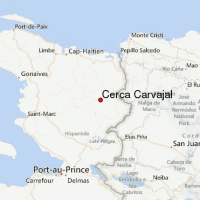Cerca-Carvajal

Cerca-Cavajal is a commune in the Hinche Arrondissement, in the Centre department of Haiti. It has 17,571 inhabitants.
The town is about thirty kilometers from the capital Hinche. Cerca-Carvajal is a city that lacks resources. Drinking water, telephone, sanitation and health care are not present. Electricity is available only in the center of Cerca-Carvajal thanks to solar panels. The access roads are in poor condition. Slums are developing in the suburbs.
Geography: It is an interior commune, its dominant relief is the mountainous and its climate is considered normal. It has an extension zone: Colomin, which is a slum. The Inhabitants of this commune Cerca Carvajal are called Carvajalais. The population of the municipality of Cerca Carvajal in 1998 was 25 977 inhabitants of which more than 75% lived in rural areas (in the only communal section owned by this municipality). In 2015, it has been recorded at 23,254 inhabitants. The area of this municipality evaluated at 155.58 km2 had a density equal to 167 inhabitants / km2 in 1998.
Economy: At the Economic and Financial level, only two commercial cooperatives have been identified. The town has no hotel, restaurant or bank.
Agriculture, Livestock and Trade are the main economic activities of the municipality. Trade is mainly with the municipalities of Hinche, Port-au-Prince and Cap-Haïtien.
The local economy is based on growing cashews, mangoes and avocados. Then, the breeding is the engine of the economy of the Carvajalaise population. The region is still forested.
Infrastructure: Cerca Carvajal, commune of the Central Department, is very poorly provided with infrastructures. Cerca-Carvajal is said to be an underdeveloped community, whose quality of life falls way below the norm of other Haitian cities. It lacks electricity and its housing material consists of adobe, mud bricks, and cheap wood.
Transportation: The town is not drained and its streets are earth and are in poor condition, especially in rainy periods. The road that connects the city to the communal section of Rang is gravel.
Education: The Ministry of National Education of Youth and Sports is not represented in the commune. Despite the misery, education is given in many schools. There are 67 primary schools (2 public and 65 private) and 4 secondary schools (1 public and 3 private). In addition, it has a family center and numerous literacy centers. There is no university or high school in Cerca Carvajal.
Health: The Ministry of Public Health and Population is not represented in the commune. On the other hand, we have inventoried a dispensary with only four auxiliaries.
Utilities: The municipality of Cerca Carvajal has four rivers and three springs. Two of these sources are collected and distributed, one for the services of the Presbytery and the other for the population of certain areas. Only the city of Cerca Carvajal is electrified.
Security: A sub-police station with nine policemen, a court of peace and a registry office constitute the Administrative and Judiciary Infrastructures of the municipality of Cerca Carvajal.
Religion: Several faiths have been listed in the commune. The majority of churches are Baptist.
Communication: At the time of the inventory, a project to set up a Teleco office was in progress. The postal service exists only in the city. The commune has neither radio station nor newspaper / magazine nor television station.
Leisure: The town has no library, museum or movie theater. The parish hall serves as a theater for some performances. Apart from the sports practiced in the municipality as: football (soccer), volleyball and basketball, twenty-three gaguères complete the meager places of entertainment and recreation of the inhabitants of the town. In the field of cultural heritage, there is also the existence of a natural site (the Zim Basin) located at the communal section of Rang.
Remoteness: Cerca-Cavajal’s remoteness is magnified by difficult terrain a traveler must navigate to get there. A trek across a limestone path on the embankment of a barren valley is necessary to reach it. Streams along the way contaminated with debris, are the only source of drinking water for people and work animals. Cholera bacteria lurks in the water, and the absence of cholera anti-prevention kits perpetuates high rates of infection.
Tourism: On the tourist level, there are many tourist sites and wonders such as:
the Grotto in Morne Cede recently discovered, the Grotto Benoit Batraville in Rang, La Roche Étampée (Woch Tanpe nan Kréyòl Ayisyen), Bassin Zim between Papaye and Demahague, the lakes in the localities of Garette and Rang, those in the locality of Rene (next to the public market of the town), the Trou Charlemagne in Pincroix (Penkwa nan Kreyol Ayisyen), Lavilokan near Roche Etampée … amongst others.
Health: With diseases infecting people such as malaria, tuberculosis, and gastrointestinal illnesses, the population is in dire need of medical intervention. One group doing remarkable work in prevention and treatment of infectious diseases is the Cuban Brigade Medical Team. They have reduced the rate of cholera cases by 23%.
With money and resources pouring in from international donors to other afflicted parts of Haiti, Cerca-Cavajal should not be ignored. A broad coalition of foundations and aid organizations pooling its resources to serve areas like Cerca-Cavajal is key to getting Haiti back on its feet since the 2010 earthquake destroyed it. No community should be underserved, especially one like Cerca-Cavajal.

